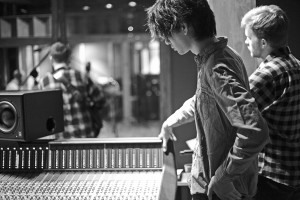 Part 2 of 2
Part 2 of 2
In this article, we will discus the pros and cons of recording live versus applying software plug-ins during post-production. And who knows, we might even discover a method that satisfies both sides of the aisle…[Editor’s note – read Part 1 here]
Best of Both Worlds?
So let’s say you have a sound dialed in on your rig that you are pretty happy with, but you’d like to hedge your bets. You’re afraid that you might not like the direction you went in when you get to the mix down stage. Wishy-washy huh? Well, you can take the best of both worlds route. “What’s that?” you say? “I can have my cake and eat it, too?” Isn’t life grand? Not so fast.
Y Not?
You will first need something to split your signal. The poor man’s method is a simple 1/4” mono “Y” cable that plugs into the output of your instrument. From here you send one signal to your pedalboard/amp to get mic’d and the other signal straight to the console. The preferred choice over a Y cable costs a bit more, though. A passive splitter like the P-Split by Lehle ($169) looks like an indestructible metal guitar stompbox and uses high-end transformers to split the signals into two 1/4” outputs. Now I hear some of you audiophiles complaining, “But that means the dry signal is still unbalanced!” You are correct, so a compromise might be the DI20 by Behringer ($25), which although not built as sturdy as the Lehle, uses active circuitry and can handle both 1/4” and XLR inputs and outputs, giving you a 1/4” output for your amp and an XLR output for your interface/console.
Endless Possibilities
Once you find (and pay for) a method that works for you, you will probably find yourself using this option to record quite frequently, because there really isn’t any downside. You use an extra track in your DAW for the second clean signal, but now you can experiment with this track and combine/replace it with the original. We often pan a version of this second rhythm guitar track hard to one side to increase the stereo spread. Or you can experiment with heavy compression on one of the two tracks. Try automating one track to come up in the mix during choruses to add extra punch, dynamics and excitement. The possibilities are limitless, so try it for yourself and have fun.
The Caveat
One caveat we have found to these rules is the electric bass. Very often we will record the bass direct using a DI box, because the advantages to this often outweigh the disadvantages. For one thing, a live bass through an amp is hard to keep isolated from other mic’d instruments – bass frequencies are big and difficult to keep contained. Another reason is that we like to put drummers and bass players in close proximity to one another (often in the same iso-room) and that means drums would leak onto a mic’d bass amp track. We rarely find that performance is an issue when bassists go direct and it is relatively easy to dial in a different bass tone using plug-ins after the performance is captured.
Plug-Ins
One downside (if you can call it that) to using software plug-ins is that there are so many great ones out there and new ones are coming out all the time. It can be hard not to feel overwhelmed. Obviously, it can get quite expensive if you want to have the latest and greatest in your arsenal. Also be warned that to be able to plug your instrument into your computer interface and listen to a plug-in live requires a lot of CPU power to achieve low-latency (latency is the time it takes for a signal to get converted to digital, be processed and then be converted back to analog so that you can hear it). You will need a very fast computer (read: fast, multi-core processor and tons of RAM) especially when you start using multiple plug-ins simultaneously (and of course you’ll want to).
I Want Candy!
Fortunately, many software manufacturers like Native Instruments (Guitar Rig 5) have free demo versions so you can try them with your system before you buy them. And, unlike a stompbox (which gives you just one effect), a good plug-in like Guitar Rig 5 has so much under the hood, you may feel like a kid in a candy store. Now, what would it sound like if I plugged my guitar into a vintage British tube amp with a 4×10 cab mic’d with a Sennheiser 421 and a little dry signal mixed in? That setup takes only a second to achieve with a plug-in – Oh my! Now, how about adding a stereo tape-delay and a bit of chorus….
Zac Cataldo is a musician and owner/producer at Night Train Studios, a recording studio in Westford, MA. He is also co-owner of Black Cloud Productions, a music publishing company. Reach him at [email protected].
Brent Godin is a bassist/guitarist and engineer/producer at Night Train Studios. He is also a talent scout at Black Cloud Productions. Reach him at [email protected].
photo by Jen Painter
